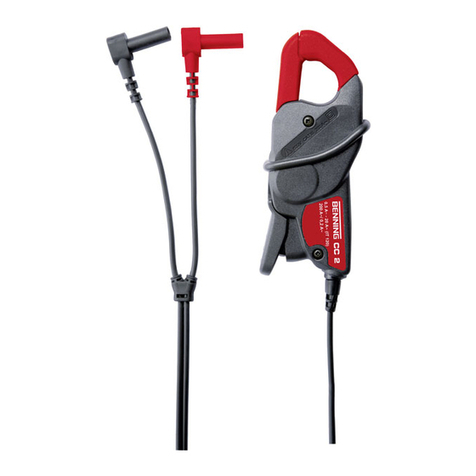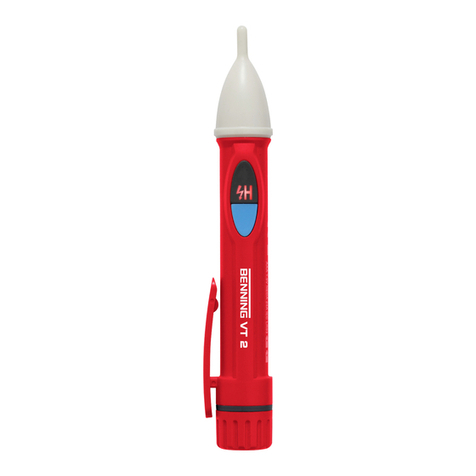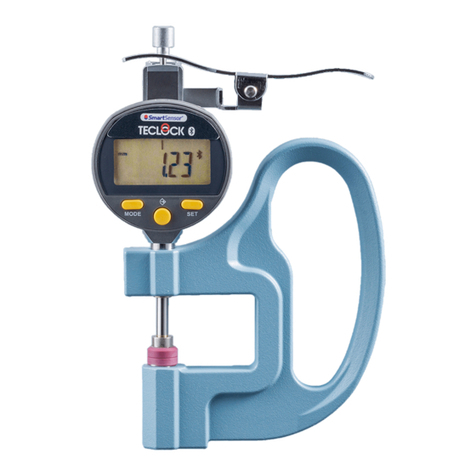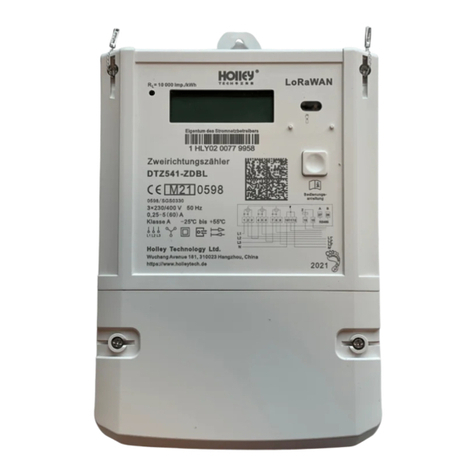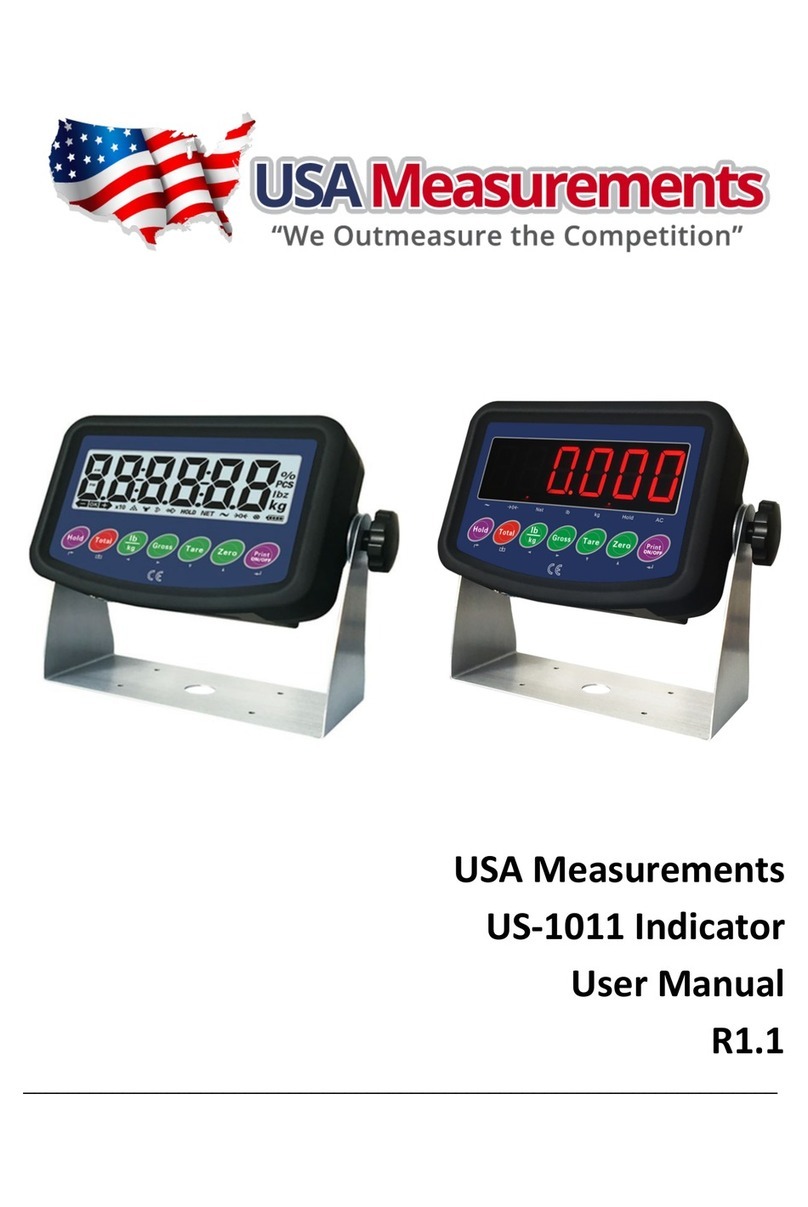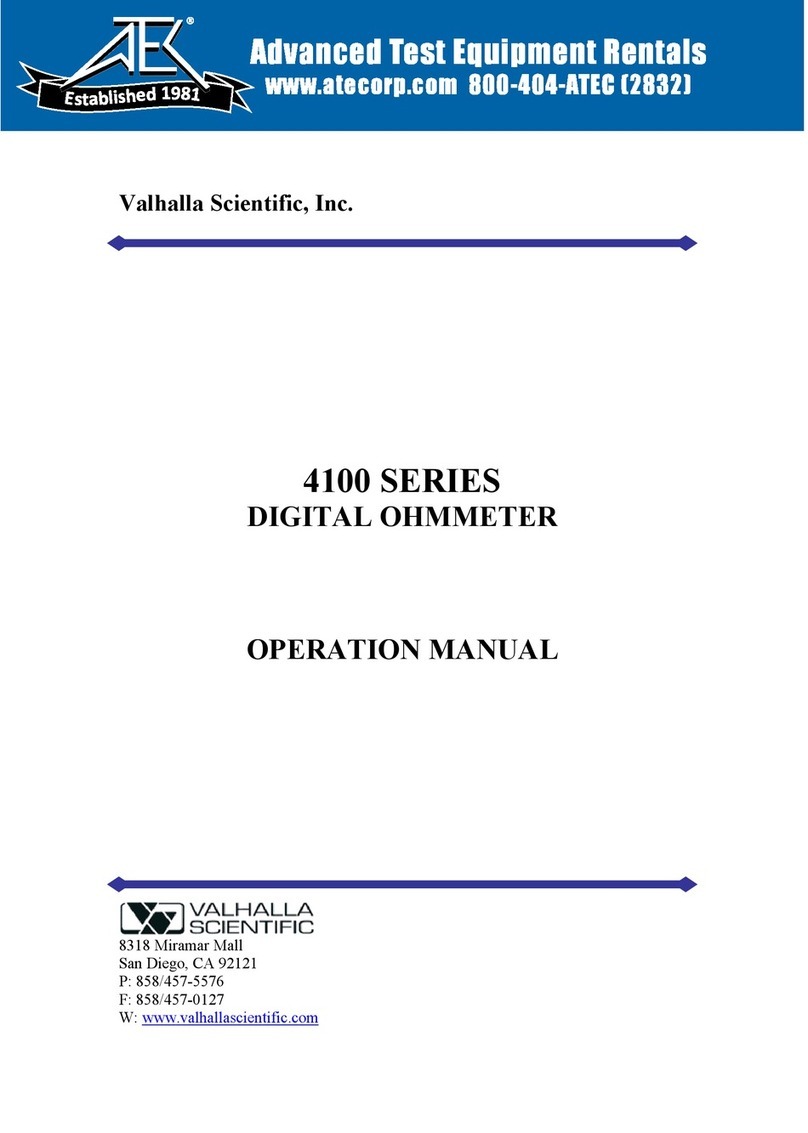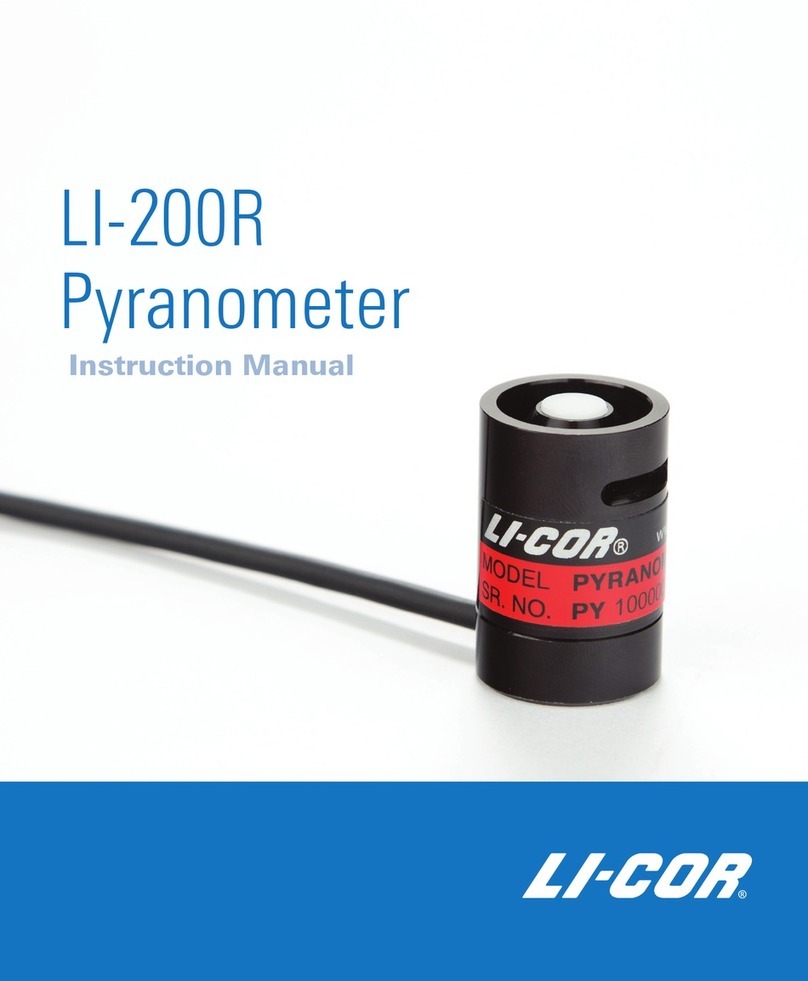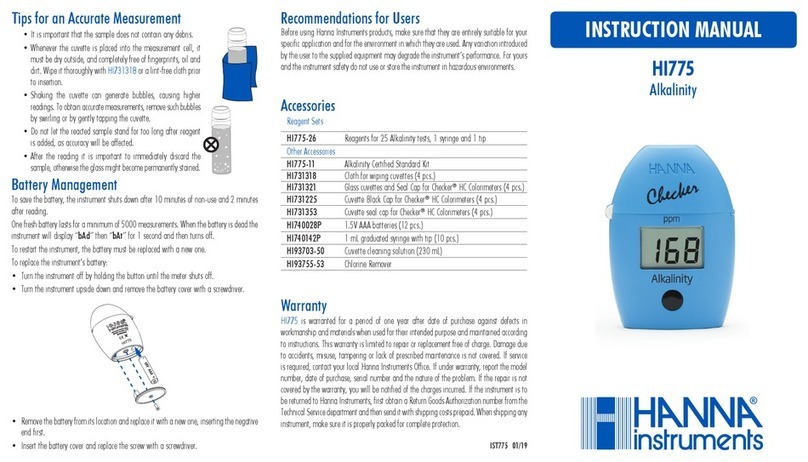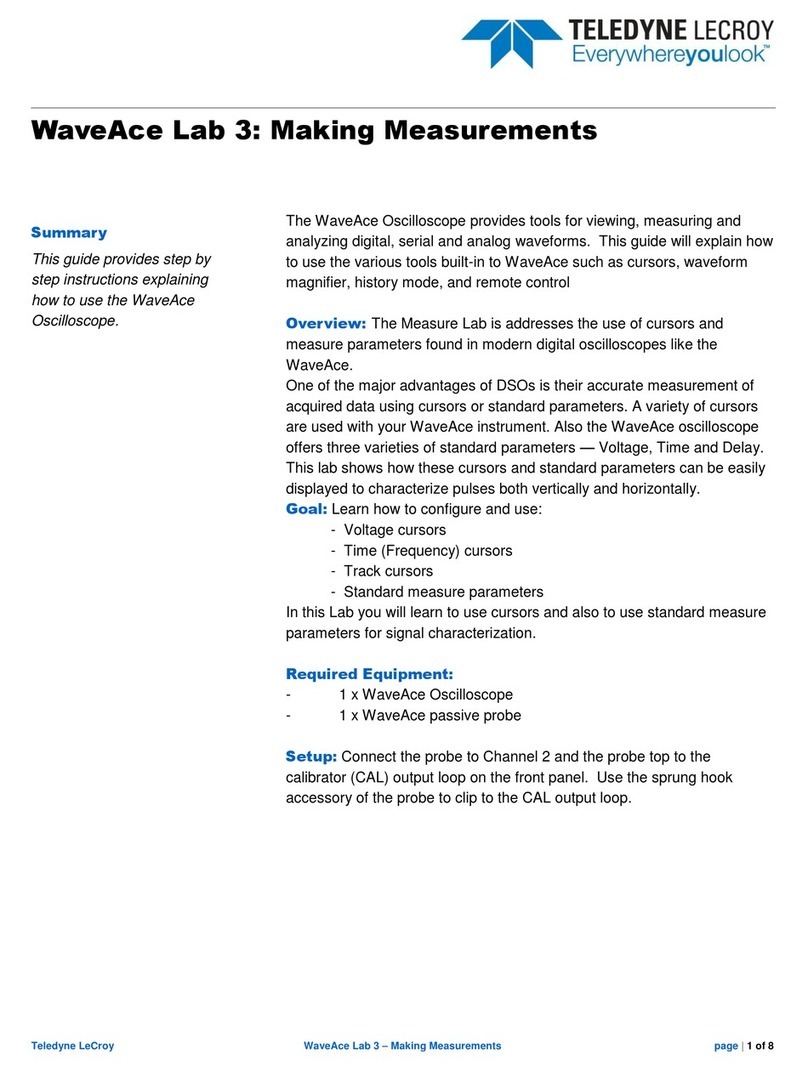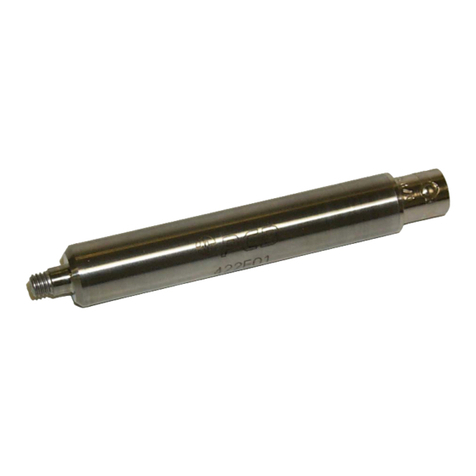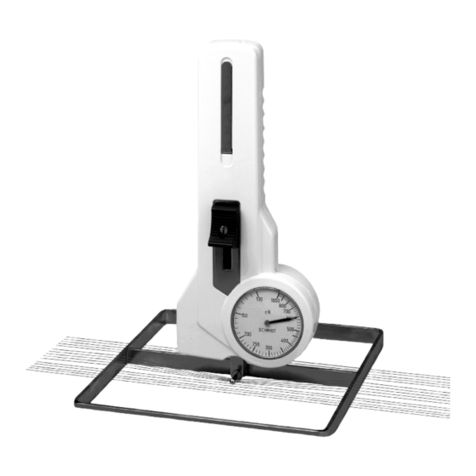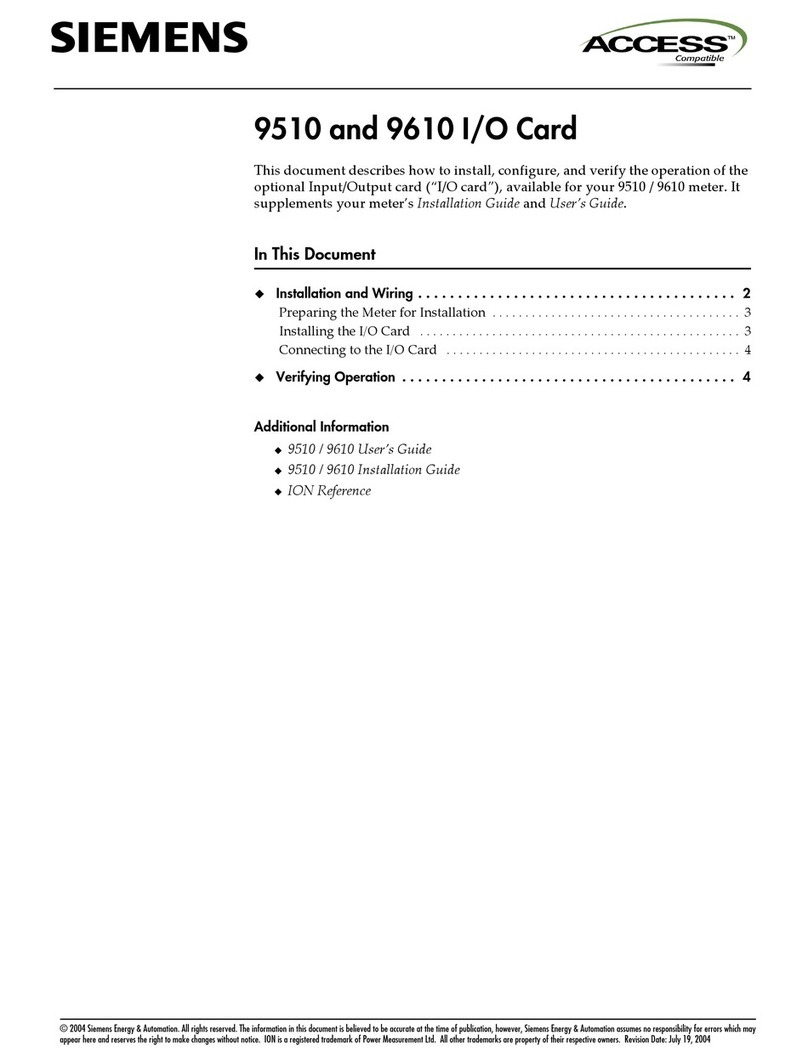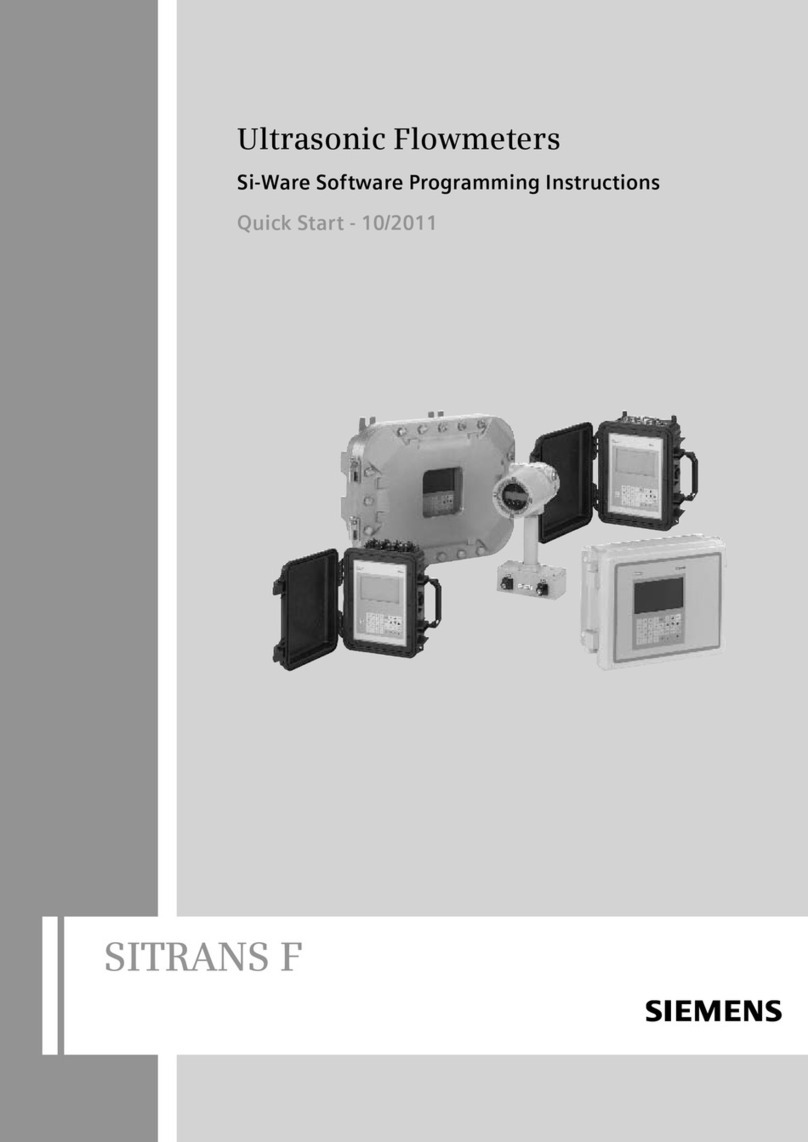Benning MM 7-2 User manual

BENNING MM 7-2
Operating manual
Translation of the German original version
5235 / 05/2022 en

Legal notice
5235 / 05/2022 enBENNING MM 7-22
Legal notice
Notes concerning the documentation
Ensure that the applicable documentation is used for this product. For safe handling, knowledge
that is provided in these instructions is required.
The product may only be handled while following this documentation, particularly the safety
instructions and warnings it contains. The personnel must be qualified for the respective task
and have the capability to recognise risks and prevent possible dangers.
Manufacturer and holder of rights
BENNING Elektrotechnik und Elektronik GmbH&Co.KG
Münsterstraße135–137
46397 Bocholt
Germany
Phone: +492871/93‑0
E-Mail: [email protected]
Internet: www.benning.de
Commercial register Coesfeld HRA No. 4661
Copyright
© 2022, BENNING Elektrotechnik und Elektronik GmbH&Co.KG
All rights reserved.
This document – particularly all of the contents, texts, photographs and graphics that it contains
– are protected by copyright.
No part of this documentation or the associated contents may be reproduced or edited, copied
or distributed using electronic media in any form (printed, photocopied or using any other
method) without express written permission.
Disclaimer
The contents of the documentation has been checked to ensure that it corresponds to the
hardware and software described. Nevertheless, deviations cannot be ruled out, so Benning
cannot guarantee complete correspondence. The contents of this documentation are checked
at regular intervals, and any corrections that are needed are contained in the versions that
follow.
General non-discrimination
Benning is aware of the importance of language with regard to the gender equality and
endeavors to take this into account at all times. To improve readability, we have refrained from
consistently using differentiating formulations.

Table of contents
Table of contents
1 Introduction................................................................................................................................................7
1.1 General notes........................................................................................................................7
1.2 History ...................................................................................................................................8
1.3 Service & support..................................................................................................................9
2 Safety........................................................................................................................................................10
2.1 Warning system ..................................................................................................................10
2.2 Standards applied ...............................................................................................................10
2.3 Symbols used......................................................................................................................11
2.4 Intended use .......................................................................................................................12
2.5 Special types of risks ..........................................................................................................14
3 Scope of delivery.....................................................................................................................................15
4 Device description...................................................................................................................................17
4.1 Device structure ..................................................................................................................17
4.2 Functions.............................................................................................................................20
4.2.1 Blue “Function” key .............................................................................................................20
4.2.2 “MINMAX” key....................................................................................................................21
4.2.3 “Hz”key...............................................................................................................................22
4.2.4 “VoltSense”key...................................................................................................................22
4.2.5 “PEAK”key..........................................................................................................................22
4.2.6 “HOLD”key .........................................................................................................................23
4.2.7 “RELΔ”key.........................................................................................................................23
4.2.8 “RANGE”key ......................................................................................................................24
4.2.9 “AutoVLoZ”function ...........................................................................................................24
4.2.10 Jack control .........................................................................................................................24
4.2.11 Further setting options ........................................................................................................25
4.3 Measuring ranges ...............................................................................................................26
4.3.1 Voltage ranges ....................................................................................................................26
4.3.2 Current ranges ....................................................................................................................28
4.3.3 Resistance ranges ..............................................................................................................29
4.3.4 Continuity test .....................................................................................................................29
4.3.5 Diode test ............................................................................................................................29
4.3.6 Capacitance ranges ............................................................................................................30
4.3.7 Frequency ranges ...............................................................................................................30
4.3.8 Temperature ranges............................................................................................................31
5 Operation..................................................................................................................................................32
5.1 Requirements for tests and measurements ........................................................................32
5.2 Connecting the safety measuring lines ...............................................................................33
5.3 Voltage, frequency or duty cycle measurement ..................................................................34
5235 / 05/2022 en BENNING MM 7-2 3

Table of contents
5.4 Current or frequency measurement ....................................................................................35
5.5 Resistance measurement or continuity testing ...................................................................36
5.6 Capacitance measurement or diode testing........................................................................37
5.7 Temperature measurement.................................................................................................38
5.8 Voltage indicator .................................................................................................................39
5.8.1 Non-contact phase testing ..................................................................................................39
5.8.2 External conductor or phase testing....................................................................................41
6 Maintenance.............................................................................................................................................42
6.1 Maintenance schedule ........................................................................................................42
6.2 Making the device free of voltage .......................................................................................42
6.3 Cleaning the device.............................................................................................................43
6.4 Replacing the batteries .......................................................................................................44
6.5 Calibrating the device..........................................................................................................44
6.6 Replacing the fuses.............................................................................................................45
7 Technical data..........................................................................................................................................46
8 Disposal and environmental protection ................................................................................................47
Index .........................................................................................................................................................48
5235 / 05/2022 enBENNING MM 7-24

Table of figures
Table of figures
Figure 1 BENNINGCFlex1 ....................................................................................................................... 15
Figure 2 BENNINGTA1............................................................................................................................ 15
Figure 3 BENNINGTA2............................................................................................................................ 16
Figure 4 BENNINGTA3............................................................................................................................ 16
Figure 5 Ø 4mm measuring lines with 2mm measuring probe ................................................................ 16
Figure 6 BENNINGMM7-2 device structure............................................................................................. 17
Figure 7 Rotary switch ............................................................................................................................... 18
Figure 8 Digital display............................................................................................................................... 19
Figure 9 Voltage, frequency or duty cycle measurement........................................................................... 34
Figure 10 Current or frequency measurement............................................................................................. 35
Figure 11 Resistance measurement or continuity test................................................................................. 36
Figure 12 Capacitance measurement or diode testing ................................................................................ 37
Figure 13 Temperature measurement ......................................................................................................... 38
Figure 14 Non-contact phase testing ........................................................................................................... 39
Figure 15 External conductor or phase testing ............................................................................................ 41
Figure 16 Battery replacement (exemplary)................................................................................................. 44
Figure 17 Fuse replacement (exemplary) .................................................................................................... 45
5235 / 05/2022 en BENNING MM 7-2 5

List of tables
List of tables
Table 1 History.......................................................................................................................................... 8
Table 2 Symbols on the device................................................................................................................. 11
Table 3 Symbols used in the operating manual........................................................................................ 11
Table 4 Selecting a function ..................................................................................................................... 20
Table 5 Low-pass filter.............................................................................................................................. 21
Table 6 Trigger thresholds........................................................................................................................ 22
Table 7 ACvoltage ranges (V‑AC, V‑AC+DC) ......................................................................................... 26
Table 8 ACvoltage ranges (HFRV‑AC)................................................................................................... 27
Table 9 DCvoltage ranges (V‑DC)........................................................................................................... 27
Table 10 Voltage ranges (LoZ, AutoV) ....................................................................................................... 27
Table 11 ACranges (A‑AC, A‑AC+DC) ...................................................................................................... 28
Table 12 DCranges (A‑DC)........................................................................................................................ 28
Table 13 4-20mA DC current loop (%) .................................................................................................... 28
Table 14 Resistance ranges(Ω) ................................................................................................................. 29
Table 15 Continuity test .............................................................................................................................. 29
Table 16 Diode test..................................................................................................................................... 29
Table 17 Capacitance ranges(F) ............................................................................................................... 30
Table 18 Mains frequency ranges(Hz)....................................................................................................... 30
Table 19 5V logic-level frequency ranges(Hz).......................................................................................... 30
Table 20 Logic-level duty cycle(%) ............................................................................................................ 31
Table 21 Temperature ranges (°C/ °F) ...................................................................................................... 31
Table 22 Maintenance schedule................................................................................................................. 42
Table 23 Technical data ............................................................................................................................. 46
5235 / 05/2022 enBENNING MM 7-26

Introduction
1.1 General notes
5235 / 05/2022 en BENNING MM 7-2 7
1 Introduction
The TRUERMS digital multimeter BENNINGMM7‑2 described here (in the following only
referred to as “device”) is intended for testing in electric circuits with a nominal voltage up to a
maximum of 1 000V‑AC or 1 000V‑DC. The device enables you to perform the following tests
and measurements:
• DC and AC voltage measurement
• DC and AC current measurement
• Resistance measurement
• Diode and continuity test
• Capacitance measurement
• Frequency and duty cycle measurement
• Temperature measurement
Further information
http://tms.benning.de/mm7‑2
On the Internet, you will find the following additional information directly at the specified link or
at www.benning.de (product search):
• Operating manual of the device in several languages
• Further information depending on the device (e.g. brochures, technical reports, FAQs)
1.1 General notes
Target group
This operating manual is intended for the following groups of people:
• Qualified electricians and electrotechnically trained personnel
Required basic knowledge
To understand these operating manual, you will need general knowledge of testing and
measuring equipment. Moreover, you will need basic knowledge of the following issues:
• General electrical engineering

1.2 History
Introduction
5235 / 05/2022 enBENNING MM 7-28
Purpose of the operating manual
This operating manual describes the device and provide you information about how to handle it.
Keep this operating manual in a safe place for later use. Read this operating manual before
handling the device and follow the instructions.
NOTE
Disclaimer of liability
Please make sure that any person using the device has read and understood the instructions of
this operating manual before handling the device and that the instructions are adhered to in all
points. Non-observance of this operating manual might result in product damage, property
damage and/or personal injury.
Benning assumes no liability for damage and malfunctions resulting from the failure to observe
the instructions in this operating manual.
The devices are subject to continuous further development. Benning reserves the right to make
changes to the device’s design, configuration and technology. The information in this operating
manual corresponds to the state of technical knowledge at the time of printing. For this reason,
no claims for certain device characteristics can be derived from the contents of this operating
manual.
Information in this operating manual can be changed at any time without prior notice. Benning is
not obligated to make amendments to this operating manual or to keep it up to date.
Direct any technical questions to Technical Support [}page9].
Trademarks
All trade marks that are used are the property of their respective owners, even if they are not
separately marked as such.
1.2 History
Release number Amendments
05/2022 • Initial release
Table1: History

Introduction
1.3 Service & support
5235 / 05/2022 en BENNING MM 7-2 9
1.3 Service & support
Please contact your specialty retailer or the BENNINGServiceCenter for any repair or service
work that might be required.
Technical support
Please contact our Technicalsupport for technical questions on handling the device.
Phone: +49287193-555
Fax: +49287193‑6555
E-Mail: [email protected]
Internet: www.benning.de
Returns management
Easily and conveniently use the BENNING returns portal for a quick and smooth returns
processing:
https://www.benning.de/service-de/retourenabwicklung.html
Phone: +49287193-554
E-Mail: [email protected]
Return address
BENNING Elektrotechnik und Elektronik GmbH & Co. KG
Retourenmanagement
Robert-Bosch-Str. 20
D - 46397 Bocholt

2.1 Warning system
Safety
5235 / 05/2022 enBENNING MM 7-210
2 Safety
2.1 Warning system
This operating manual contains notes that must be taken into consideration for your personal
safety and in order to avoid injuries and damage to property. Warnings about your personal
safety and to prevent personal injuries are marked with a warning triangle. Warnings on sole
prevention of material damage are shown without a warning triangle. The warnings are shown
in descending order depending on the hazard level as follows.
DANGER
Extremely dangerous situation for humans
If you do not pay attention to this warning, irreversible or deadly injuries will occur.
WARNING
Hazard to humans
If you do not pay attention to this warning, irreversible or deadly injuries could occur.
CAUTION
Minor hazard to humans
If you do not pay attention to this warning, minor or moderate injuries could occur.
NOTICE
Danger to property, not to persons
If you do not pay attention to this warning, material damage could occur.
If multiple hazard levels occur, the warning for the highest respective hazard level will be used.
In addition, a warning about personal injuries can also include a warning about material
damage.
2.2 Standards applied
The device has been built and tested in compliance with the following standards and has left the
factory in perfectly safe condition.
• IEC/ DINEN61010-1 (VDE0411‑1)
• IEC/ DINEN61010-2-033 (VDE0411‑2‑033)
• IEC/ DINEN 61010-031 (VDE0411‑031)

Safety
2.3 Symbols used
5235 / 05/2022 en BENNING MM 7-2 11
2.3 Symbols used
Symbols on the device
Symbol Meaning
Please observe the information provided in this operating manual in
order to avoid dangers.
Warning of electrical danger! Please observe the information provided
in this operating manual in order to avoid dangers.
CAT II Measuring categoryII is applicable to testing and measuring circuits
which are directly connected to user connections (e.g. sockets) of the
low-voltage mains installation.
CAT III Measuring categoryIII is applicable to testing and measuring circuits
connected to the distribution circuit of the low-voltage mains installation
of a building.
CAT IV Measuring categoryIV is applicable to testing and measuring circuits
connected to the feeding point of the low-voltage mains installation of a
building.
The device complies with EU directives.
The device complies with UK directives.
At the end of product life, dispose of the unserviceable device via
appropriate collecting facilities provided in your community.
The device is provided with protective insulation (protection classII).
This symbol indicates the inserted batteries.
Please observe the operating manual.
(DC) direct voltage or direct current
(AC) alternating voltage or alternating current
Earth (voltage to earth)
Table2: Symbols on the device
Symbols used in the operating manual
Symbol Meaning
General warning
Warning of electric voltage!
Table3: Symbols used in the operating manual

2.4 Intended use
Safety
5235 / 05/2022 enBENNING MM 7-212
2.4 Intended use
Only use the device within the framework of the corresponding technical data. Any operating
conditions that deviate from this shall be considered as improper use. Solely the user of the
device shall be liable for any resulting damage.
In particular, note the following:
• In case of improper use, the liability and warranty claims become void. Solely the user of the
device shall be liable for any damage resulting from improper use. Uses not complying with
the intended use include e.g.:
– Use of components, accessories, spare or replacement parts that have not been
released and approved for the respective application by Benning
– Non-observance, manipulation, changes or misuse of the operating manual or the
instructions and notes contained therein
– Any form of misuse of the device
– Any use other than or beyond that described in this operating manual
• Warranty and liability claims are generally excluded if damage is due to force majeure.
• If any prescribed services are not performed regularly or not on time according to
manufacturer specifications during the warranty period, a decision about a warranty claim
can only be made once the findings are available.
Direct any questions to Technical Support [}page9].
Using the device
Please observe the following basic obligations when using the device:
• The device may only be used in a technically perfect and safe condition. Always check the
device for damages before using it.
• Make sure the personnel using the device is qualified for the respective task.
• Observe relevant regulations on occupational safety and health as well as those on
environmental protection.
• The device may only be used inside buildings and in dry environments.
• Do not use the device in potentially explosive environments.
• Use the device only in electric circuits up to overvoltage categoryCATIII with a conductor
for a maximum of 1 000V or up to overvoltage categoryCATIV with a conductor for a
maximum of 600V to earth.
• Use suitable (approved) safety measuring lines. For measurements in electric circuits of
overvoltage categoryCATIII or CATIV, the protruding conductive part of a contact tip of the
safety measuring line must not be longer than 4mm. Before measuring, attach the enclosed
protective caps onto the contact tips (marked with CATIII and CATIV).
• In order to detect a dangerous voltage and to prevent any danger, always measure a
present voltage first without low-pass filter (without high-frequency suppression “HFR”).
• Do not use the “AutoVLoZ” measuring function for voltage measurement on sensitive
electronic circuits. The initially low input resistance might briefly generate current peaks of
up to 673mA (1 000Vx 1.414/ 2.1kΩ).
• In order to prevent any danger due to incorrect measurements, replace discharged batteries
immediately.
• In order to prevent any danger, replace a defective fuse immediately.

Safety
2.4 Intended use
5235 / 05/2022 en BENNING MM 7-2 13
WARNING
Dangerous voltage
Danger to life or serious injury is possible due to contact with high electric voltage in case of
incorrect operation.
• Do not touch the bare measuring probe tips of the safety measuring lines or the bare
contacts of the optional alligator clips. Only touch the safety measuring lines in the area
intended for your hands.
• Connect the safety measuring lines to the correspondingly marked measuring jacks of the
device and check them for tight fit.
• Only use approved safety measuring lines.
• Attach the protective caps to the contact tips of the safety measuring lines (circuits of
overvoltage category CATIII orIV).
• When disconnecting the measuring circuit, first remove the live safety measuring line
(phase) and then the neutral safety measuring line from the measuring point.
WARNING
Opening the device
Danger to life or serious injury is possible due to contact with high electric voltage when opening
the device. The device might get damaged.
• Make sure that the device is free of voltage before opening the battery compartment or
housing.
• Do not open the device (except for the battery compartment and replacing a fuse).
• Please contact your specialty retailer or the returns management for any repairs [}page9].
Securing the device
If the device is not in a technically perfect and operationally safe condition, safe operation is no
longer guaranteed. Make sure that the following measures are taken:
• Switch off the device.
• Remove the device from the measuring point.
• Secure the device against unintentional operation.
The following characteristics indicate that safe operation is no longer guaranteed:
• The device (housing or safety measuring lines) shows visible damage or is damp/wet.
• The insulation of the safety measuring lines is damaged.
• The device does not work properly in compliance with regulations (e.g. errors during
measurements).
• The device shows recognisable consequences of prolonged storage under inadmissible
conditions.
• The device shows recognisable consequences of extraordinary stress due to transport.

2.5 Special types of risks
Safety
5235 / 05/2022 enBENNING MM 7-214
2.5 Special types of risks
DANGER
Bare conductors or main line carriers
Danger to life or serious injury is possible due to contact with high electric voltage when working
with bare conductors or main line carriers.
• Please observe relevant regulations on occupational safety and health.
• If necessary, use appropriate protective equipment.
WARNING
Dangerous voltage
Danger to life or serious injury is possible due to contact with high electric voltage when working
on live components or equipment. Even low voltages from 30V‑AC and 60V‑DC on can be
dangerous to human life!
• Please observe relevant regulations on occupational safety and health.
• If necessary, use appropriate protective equipment.

Scope of delivery
2.5 Special types of risks
5235 / 05/2022 en BENNING MM 7-2 15
3 Scope of delivery
The scope of delivery of the device includes the following components:
• 1x TRUERMS digital multimeter BENNINGMM7-2 (item no.: 044690)
• Silicone safety measuring lines (item no.: 10231315):
– 1x silicone safety measuring line (red, l=1.0m)
– 1x silicone safety measuring line (black, l=1.0m)
• 1x wire temperature sensor of typeK (l=93cm±3cm, item no.: 10231316)
• 1x compact protective pouch (item no.: 010913)
• 3x 1.5V micro batteries (AAA/ IECLR03)
• Fuses (integrated into the device for initial assembly):
– 1x fuse F1 (F 11A, 1 000V, 20kA)
– 1x fuse F2 (F 0.4A, 1 000V, 30kA)
• 1x operating manual
Optional accessories
• Flexible AC current transformer BENNINGCFlex1 (item no.: 044068)
ACrange: 30A/ 300A/ 3 000A
Figure1: BENNINGCFlex1
• Set of safety measuring lines BENNINGTA1 (item no.: 044124)
Ø 4mm alligator clips, 2‑piece, red/ black, professional version, CATIII 1 000V, 36A
Figure2: BENNINGTA1

2.5 Special types of risks
Scope of delivery
5235 / 05/2022 enBENNING MM 7-216
• Set of safety measuring lines BENNINGTA2 (item no.: 044125)
Set of Ø 4mm measuring lines, 6‑piece, red/ black, professional version, consisting of:
– Measuring lines (silicone) (CATIII 1 000V)
– Test probes (4mm measuring probe, CATII 1 000V)
– Alligator clips (CATIII 1 000V)
Figure3: BENNINGTA2
• Set of safety measuring lines BENNINGTA3 (item no.: 044126)
Set of Ø 4mm measuring lines, 8‑piece, red/ black, professional version, CATIII 1 000V,
consisting of:
– Measuring lines (silicone)
– Test probes (slender measuring probe)
– Grabber clips
– Alligator clips
Figure4: BENNINGTA3
• Set of Ø4mm safety measuring lines with 2mm measuring probe (item no.: 044146)
Ø4mm measuring lines, 2‑piece, red/ black, l=1.40m, with 2mm measuring probe,
CATIV 600V/ CATIII 1 000V (with protective caps), CATII 1 000V (without protective
caps)
Figure5: Ø 4mm measuring lines with 2mm measuring probe

Device description
4.1 Device structure
5235 / 05/2022 en BENNING MM 7-2 17
4 Device description
4.1 Device structure
12
3
5
6
12
11
78
9
10
4
4
Figure6: BENNINGMM7-2 device structure
1 Front panel of the device 2 Rear panel of the device
3 Battery compartment 4 Holder for engaging a safety measuring
line
5 Foldable stand 6 Jack for V, Ω, diode, capacitance,
temperature
7 COMjack 8 Jack for A
9 Jack for μA/ mA 10 Rotary switch
11 Function keys 12 Digital display
Rear panel of the device
• Foldable stand
• Battery compartment
The device is powered by three 1.5V micro batteries (AAA/ IECLR03).
• Holders for engaging the safety measuring lines
You can store the safety measuring lines by wrapping them around the housing and
engaging the measuring probes and the gripping areas onto the housing in a protective way.
• 2labels with notes and information about the device
• Serial number (label)

4.1 Device structure
Device description
5235 / 05/2022 enBENNING MM 7-218
Rotary switch
You can set the desired test or measurement by means of the rotary switch.
12 3 456
7
8
9
10
11
Figure7: Rotary switch
1 AC voltage measurement (V‑AC) 2 Voltage measurement (V)
3 Voltage (mV), frequency or duty cycle
measurement
4 Resistance measurement (Ω) or
continuity test
5 Capacitance measurement or diode
test
6 Temperature measurement
7 Current measurement (A/ mA) 8 Current measurement (μA)
9 Setting of the rotary switch 10 Voltage measurement (AutoVLoZ)
11 Device switched off (OFF)

Device description
4.1 Device structure
5235 / 05/2022 en BENNING MM 7-2 19
Digital display
The digital display is divided into different sections:
• Display of the currently set functions and units
• Display range: 5-digit liquid crystal display(LCD) with a font size of 15mm and decimal
points. The highest display value is 60 000digits.
• Bargraph indication with 30segments
• Battery status: Indicates the empty state of charge of the batteries. When the symbol
appears, the batteries are discharged.
• Polarity display (automatic): Indicates a polarity contrary to the jack definition with “-”.
The maximum nominal measuring rate of the device is 5measurements per second for the
digital display and 50measurements per second for the bargraph indication. For reading the
values in dark lighting conditions, the digital display is provided with a background lighting
[}page21].
12
3
45
1
6
Figure8: Digital display
1 Display of functions 2 Battery status
3 Display range 4 Display of units
5 Bargraph indication 6 Polarity

4.2 Functions
Device description
5235 / 05/2022 enBENNING MM 7-220
4.2 Functions
Use the rotary switch to switch the device on (desired measuring function) or off (“OFF”).
The device confirms each operation of keys with an acoustic signal. The device switches off
automatically after approx. 30minutes (APO, Auto-Power-Off). To switch the device back on,
press the “HOLD” key or first set the rotary switch to switch position “OFF” and then set the
desired measuring function.
4.2.1 Blue “Function” key
Selecting a function
Press the blue “Function” key to select the second, third, fourth or fifth function of the respective
rotary switch position.
The last selected function will be stored for each rotary switch position and automatically
preselected when setting the function again and after switching the device on again.
Rotary switch position
(symbol/ designation)
Functions
AutoVLoZ AutoVLoZ
V‑AC V‑AC → HFR
V V‑DC → V‑AC+DC
mV mV‑DC → mV‑AC → mV‑AC+DC → logic (Hz) → logic (%)
Ω Ω → continuity
Capacitance
measureme
nt
Capacitance → diode
Temperatur
e
measureme
nt
°C → °F
A/ mA A/ mA‑DC → A/ mA‑AC → A/ mA‑AC+DC → 4‑20mA (%)
μA μA‑DC → μA‑AC → μA‑AC+DC
Table4: Selecting a function
Table of contents
Other Benning Measuring Instrument manuals

Benning
Benning LD 60 User manual
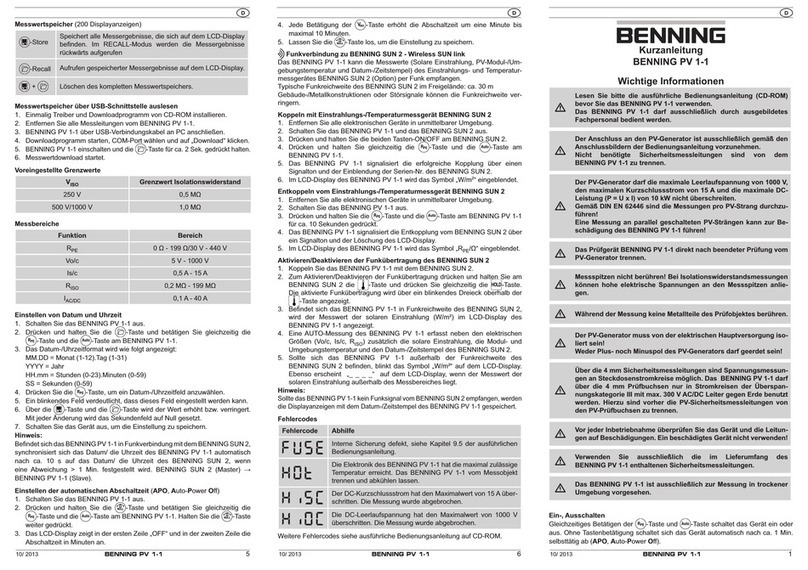
Benning
Benning PV 1-1 Manual
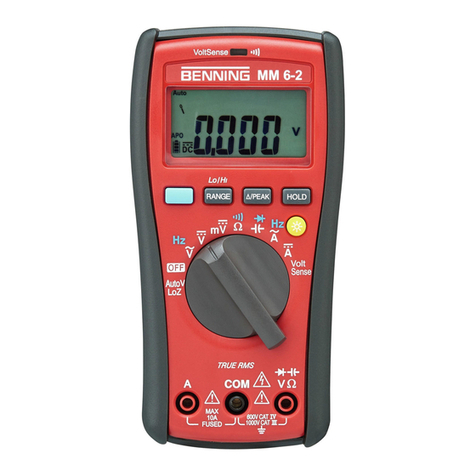
Benning
Benning MM 6-1 User manual

Benning
Benning CFlex 1 User manual
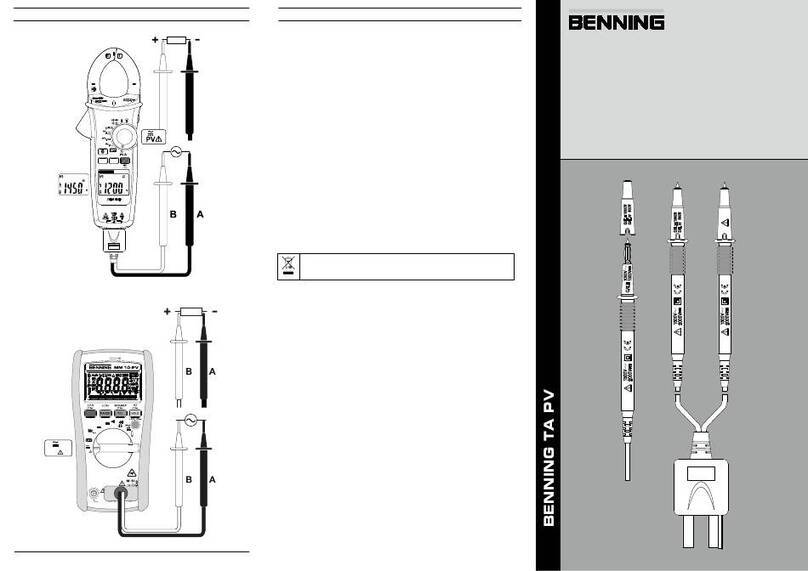
Benning
Benning TA PV User manual
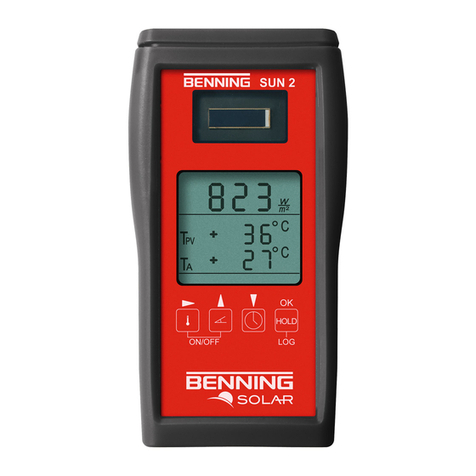
Benning
Benning Sun 2 User manual

Benning
Benning ST 725 User manual
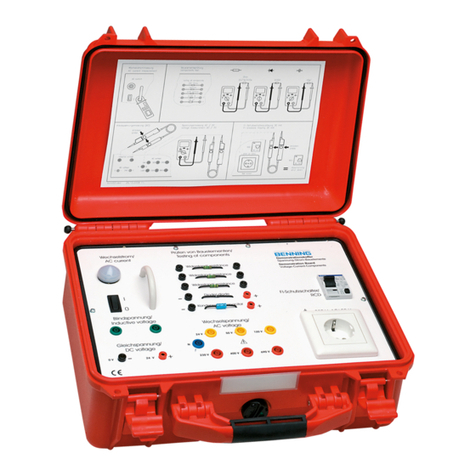
Benning
Benning DB 1 User manual

Benning
Benning CM 1 User manual
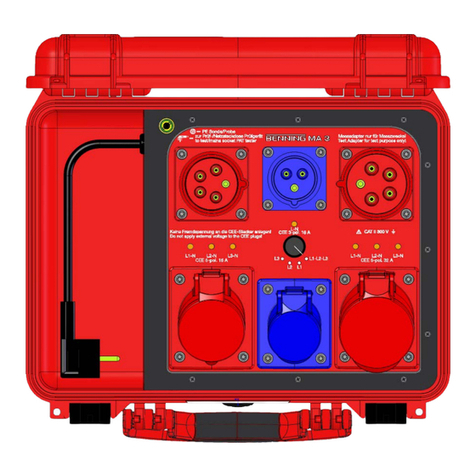
Benning
Benning MA 3 User manual
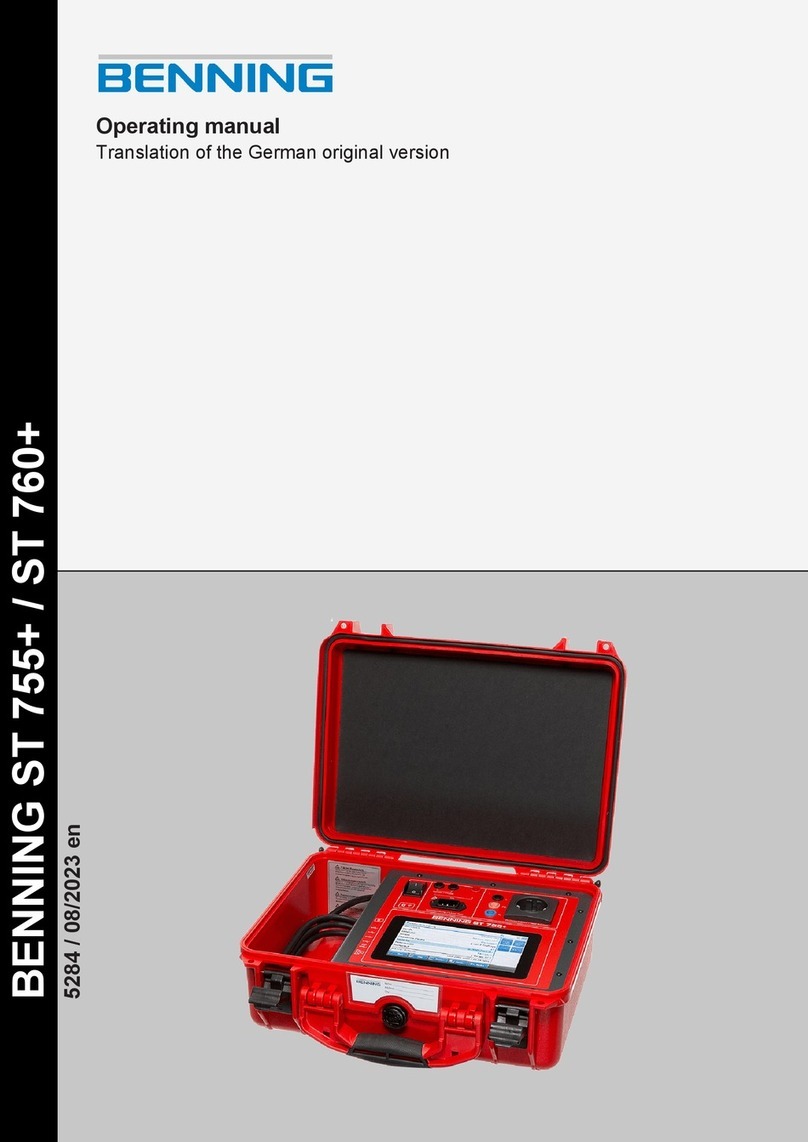
Benning
Benning ST 755+ User manual
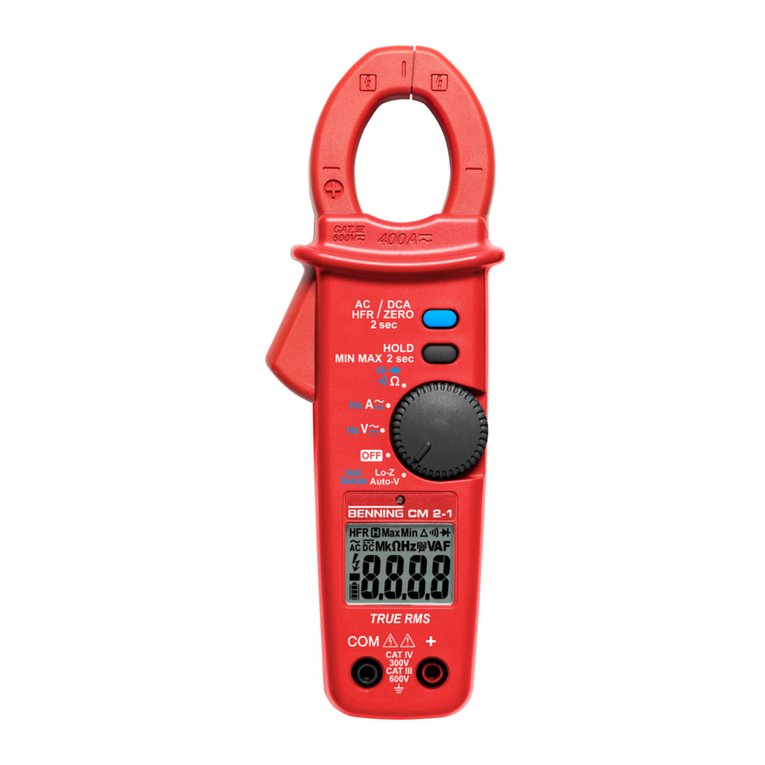
Benning
Benning CM 2-1 User manual

Benning
Benning Sun 2 User manual
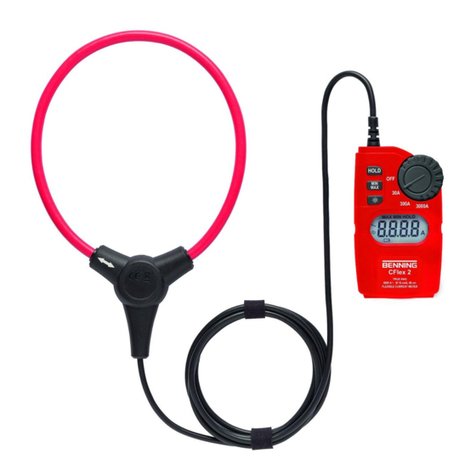
Benning
Benning CFlex 2 User manual
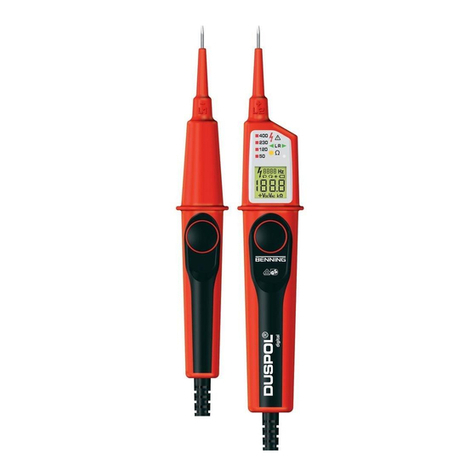
Benning
Benning DUSPOL User manual
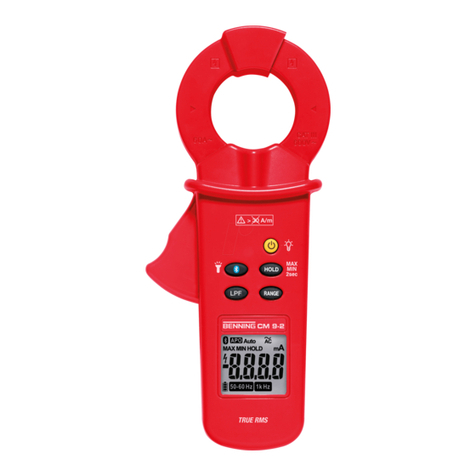
Benning
Benning CM 9-2 User manual
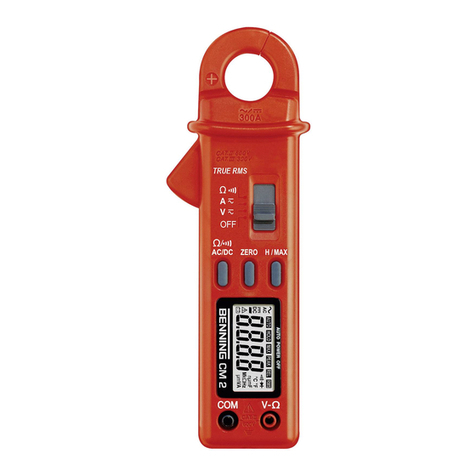
Benning
Benning CM 2 User manual
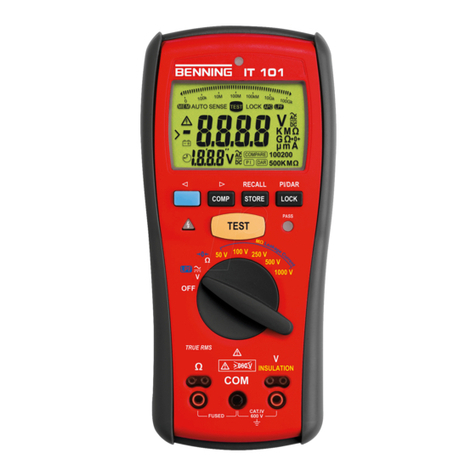
Benning
Benning IT 101 User manual
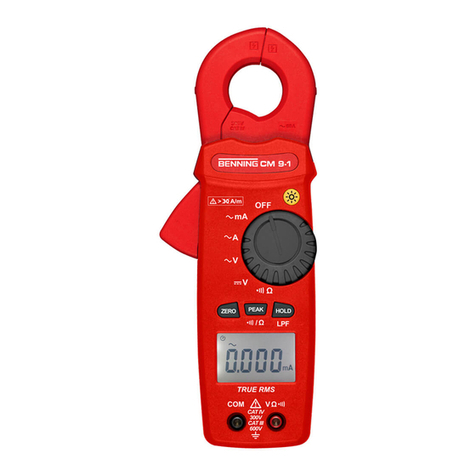
Benning
Benning CM 9-1 User manual
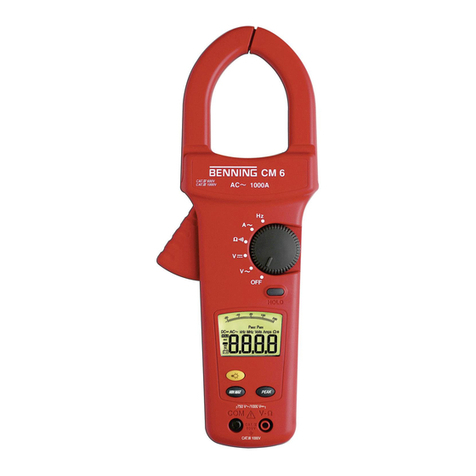
Benning
Benning CM 4 User manual

